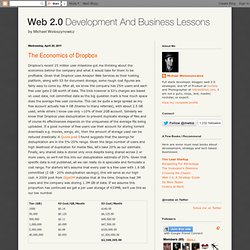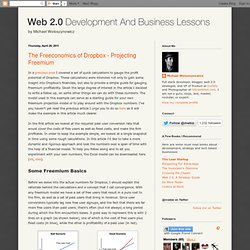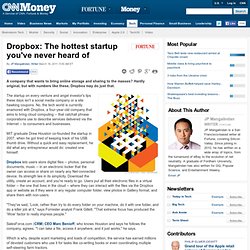

Dropbox: The Inside Story Of Tech's Hottest Startup. Index Leads $4 billion Valuation Round In Dropbox. Dropbox is finally moving to close that massive valuation venture round we’ve been talking about all summer.

According to multiple sources, Index Ventures will lead the round, which values Dropbox at around $4 billion. At some point I hope that the entire story comes out about this round. Nearly everyone in Silicon Valley has taken a look. There was early interest at valuations of $8 billion or more, although one source says that it may have been firms who threw out huge numbers just to get a look at the company’s financials. As of a couple of weeks ago I had “firm” information that the round would close at $5 billion or more. As far as I can tell, that information was accurate at the time. I’m hearing two reasons.
There’s a relatively large investor syndicate, say our sources, with involvement from a variety of firms beyond Index. Dropbox Raising Massive Round at a $5B-Plus Valuation. We’ve heard from multiple sources that Dropbox is finally moving on raising its next venture round and it’s a whopper.

They’ve had preliminary conversations with several investors, several solid offers they’ve passed on earlier this year and are meeting with investment banks to handle the offering now. Allen & Co. is said to be in the mix, but we’ve also heard nothing has been finalized. The real news are the numbers we’re hearing from multiple sources close to the company. Dropbox is looking to raise between $200 million and $300 million according to these sources.
In terms of valuation, the company has already had multiple offers at a valuation north of $2 billion range, and recently more informal discussions in the $8 billion-valuation range. The Economics of Dropbox. Dropbox's recent 25 million user milestone got me thinking about the economics behind the company and what it would take for them to be profitable.

Given that Dropbox uses Amazon Web Services as their hosting platform, along with S3 for document storage, some rough cost figures are fairly easy to come by. After all, we know the company has 25m users and each free user gets 2 GB worth of data. The trick however is S3's charges are based on used data, not committed data so the big question mark is how much space does the average free user consume. This can be quite a large spread as my free account actually has 4 GB (thanks to many referrals), with about 2.5 GB used, while others I know use only ~10% of their 2GB account. Similarly we know that Dropbox uses deduplication to prevent duplicate storage of files and of course its effectiveness depends on the uniqueness of the average file being uploaded.
In addition to storage we have to factor in S3's per request cost. The Freeconomics of Dropbox - Projecting Freemium. In a previous post I covered a set of quick calculations to gauge the profit potential of Dropbox.

These calculations were intended not only to gain some insight into Dropbox's financials, but also to provide a simple guide for gauging freemium profitability. Given the large degree of interest in the article I decided to write a follow up, on some other things we can do with these numbers. The model used in this example can serve as a starting guide for your own freemium projection model or to play around with the Dropbox numbers.
I've you haven't yet read the previous article I urge you to do so here as it will make the example in this article much clearer. In the first article we looked at the required paid user conversion rate that would cover the costs of free users as well as fixed costs, and make the firm profitable. Some Freemium Basics Above we can see two scenarios, one where the line's diverge, and another where they converge. Dropbox: The hottest startup you've never heard of. A company that wants to bring online storage and sharing to the masses?

Hardly original, but with numbers like these, Dropbox may do just that. The startup on every venture and angel investor's lips these days isn't a social media company or a site hawking coupons. No, the tech world is currently enamored with Dropbox, a four-year-old company that aims to bring cloud computing -- that catchall phrase corporations use to describe services delivered via the Internet -- to consumers and businesses. MIT graduate Drew Houston co-founded the startup in 2007, when he got tired of keeping track of his USB thumb drive. Without a quick and easy replacement, he did what any entrepreneur would do: created one himself. Dropbox lets users store digital files -- photos, personal documents, music -- in an electronic locker that the owner can access or share on nearly any Net-connected device.
SalesForce.com (CRM) CEO Marc Benioff, who knows Houston and says he follows the company, agrees. Dropbox Updates Apps for Android, iOS; Launches App Directory And BlackBerry App. Dropbox, which develops an easy-to-use file sharing service, is releasing a new set of mobile apps today, including updates for the startup’s iPhone, iPad and Android apps, and the first release of Dropbox for BlackBerry (which the company hinted at earlier this year).

And DropBox is launching an app directory complete with app information, screenshots and reviews for the over 100 third party mobile applications that use the company’s mobile APIs for document editing, image capture, note taking and more. DropBox opened up its mobile API in May, along with the initial launch of the company’s Android App. The startup, which won a Crunchie for Best Internet Application at this year’s recent awards ceremony, enables people to sync files and media across platforms and devices, in order to have them available from any location.